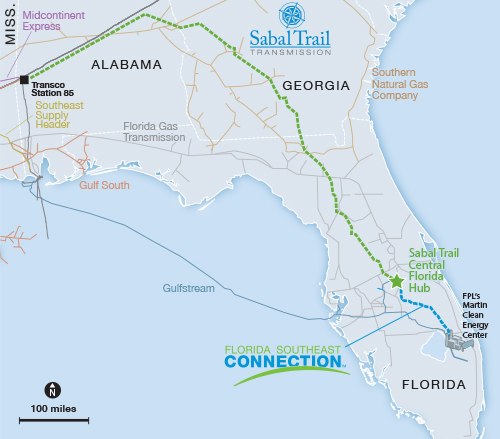Sabal Trail Transmission & Florida Southeast Connection
To ensure we have reliable access to the clean, affordable, U.S.-produced fuel necessary to meet the growing electricity needs of the state’s residents and businesses, FPL issued a request-for-proposals (RFP) in December 2012 for new natural gas transportation infrastructure into and within Florida beginning in 2017. After a fair, competitive evaluation process, FPL determined that the best, most economical solution is a combination of a natural gas pipeline and interconnection hub to be built by Sabal Trail Transmission, LLC, and a second natural gas pipeline to be built by Florida Southeast Connection, LLC.
- Sabal Trail Transmission: Sabal Trail Transmission, a joint venture of Spectra Energy Corp., NextEra Energy, Inc., and Duke Energy, will include approximately 465 miles of interstate natural gas pipeline that will originate in southwestern Alabama and transport natural gas to Georgia and Florida. It will terminate at a new Central Florida Hub south of Orlando, Fla., where it will interconnect with the two existing natural gas pipelines that currently serve central and southern Florida. The Sabal Trail pipeline will be capable of transporting more than 1 billion cubic feet per day of natural gas to serve local distribution companies, industrial users and natural gas-fired power generators in the Southeast.
- Florida Southeast Connection: Florida Southeast Connection, LLC is a wholly owned subsidiary of NextEra Energy. To connect with FPL’s operations, Florida Southeast Connection is constructing a separate, 126-mile pipeline from Sabal Trail’s Central Florida Hub to FPL’s Martin Clean Energy Center in Indiantown, Fla.
The two projects are expected to be completed and begin delivering natural gas to FPL’s system in mid-2017. FPL will purchase approximately 400 million cubic feet per day beginning in 2017, increasing to about 600 million cubic feet per day in 2020.
Project timeline
- December 2012: FPL issues RFP for new natural gas infrastructure.
- July 2013: FPL selects two companies to build two pipeline systems.
- Fall 2013: Sabal Trail and Florida Southeast Connection begin permitting process with the Federal Energy Regulatory Commission.
- August 2016: Construction begins.
- Mid-2017: The two pipeline systems begin delivering natural gas into FPL’s system.
Regulatory approvals
The two pipeline projects were evaluated and approved by federal, state and local government regulatory agencies .
Florida Public Service Commission (PSC)
In 2013, FPL received a determination from the PSC that it was prudent for the company to enter into contracts with the pipeline projects that were selected through the RFP process. In other words, the PSC had to approve FPL’s selection of the winning projects before they could move forward. The PSC also has oversight over FPL’s rates and the fuel clause, which will be the vehicle by which FPL customers will pay for the use of the new pipelines.
Federal Energy Regulatory Commission (FERC)
Both Sabal Trail and Florida Southeast Connection are interstate natural gas pipelines that were approved by the Federal Energy Regulatory Commission and are subject to ongoing FERC oversight. FERC authorized the construction of the projects in August 2016 after conducting the necessary environmental reviews to ensure the pipelines’ compliance with the National Environmental Policy Act.
Other Approvals
A number of other federal, state and local government agencies were involved as well, including the U.S. Army Corps of Engineers, U.S. Fish and Wildlife Service, and the appropriate agencies in Florida, Georgia and Alabama.
The regulatory review and permitting processes followed by the federal, state and local government agencies allowed interested stakeholders multiple opportunities to comment on the two proposed pipeline projects. Please visit Sabal Trail and Florida Southeast Connection for more information on the permitting process.
Project costs
FPL needs additional fuel to generate affordable clean energy for its customers in 2017, and the new pipelines are the most cost-effective method to provide that fuel. FPL’s economic analysis showed that these projects will save FPL customers nearly $600 million compared with the next closest proposal.
FPL customers will not directly pay to construct the two pipelines, and customers won’t begin to pay any costs associated with the new pipelines until they actually enter service, which is anticipated to be mid-2017. FPL will purchase fuel transportation capacity from the pipelines when they enter service in 2017 and recover the cost through the Fuel Clause on customer bills, just as the company does currently with the two existing pipelines that serve FPL’s system.
